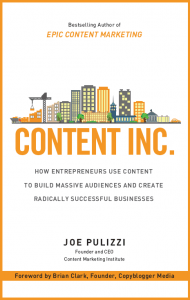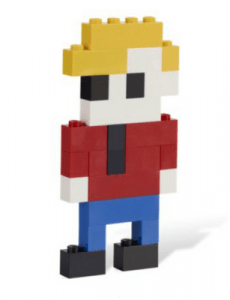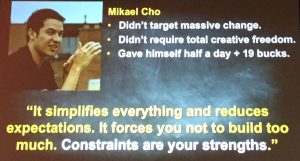
Content Marketing & Other Cheap Tricks
If Content marketing had a theme song!
Which song would you nominate?
I hereby nominate my favorite Cheap Trick song, “I Want You to Want Me.” Cheap Trick played at Content Marketing World 2016.
https://youtu.be/BJs_L7yq5qE
If your content could sing, wouldn’t it sing a song like this to your customers?
“I want you to want me,
I need you to need me,
I’d love you to love me,
I’m begging you to beg me.”
In the eyes of your customers, great content is wanted, needed and loved.

The song’s musical hook is so strong, you just can’t resist it. As Joe Pulizzi observed in his book Content Inc., content marketing needs that kind of tilt or hook that demands attention.
The quality of “I Want You to Want Me” is great, so it’s easy to remember. Days later, the song is still playing in my head.
Content that your audience recalls days later is rare
It’s tough to break through and become the 10% of things your audience remembers, instead of the 90% they forget.
“I Want You to Want Me” has a crystal-clear call to action (CTA). There’s no doubt about what to do next. If you respond, there’s a clear promise about what will happen:
“I’ll shine up the old brown shoes,
Put on a brand new shirt.
I’ll get home early from work
If you say that you love me.”
Respond to the offer – and we’ll clean up, send our best sales person to you early and pay undivided attention to you. That’s what buyers really want, yet so rarely find – a special attention, some relevant content, some love.
When content marketing’s attention turns to buyers (where it belongs), wise marketers probe customer pain points:
“Didn’t I, didn’t I, didn’t I see you crying?
Oh, didn’t I, didn’t I, didn’t I see you crying?
Feeling all alone without a friend, you know you feel like dying
Oh, didn’t I, didn’t I, didn’t I see you crying?”
Everyone needs a friend to listen, to soothe them, to figure out how to meet their needs. A little bit of empathy goes a long way in content marketing, as Andy Crestodina says.
When we see the world through our customers’ eyes, everything becomes far more clear. A buyer in pain is a person looking for someone to help solve a problem.
That’s why marketing can’t get too close to customers
The more time we spend with customers, the better we understand their questions, needs and pain points.
Great content marketing even learns to speak customers’ language. The more we speak customer, the more relevant and resonant all our content will become.
What Cheap Trick did brilliantly during the concert was to involve the audience in content creation. At the end of the song “I Want You to Want Me,” guitarist Robin Zander came to the edge of the stage and let audience members strum the last chords.

Here’s a picture from that moment, taken by my friend Suzanne Martin. See that hand on the strings? That’s me!
To a guitarist like me, that experience was pure magic. For a few seconds I got to play my favorite Cheap Trick song with Cheap Trick! Forever unforgettable.
That moment also shows how user-generated content totally trumps marketer-generated content. There’s nothing a marketer can do that’s more powerful than delivering a great, once-in-a-lifetime customer experience.
Great experiences inspire people to create their own content, as Carla Johnson and Robert Rose said in their book Experiences: The 7th Era of Marketing.
Cheap Trick made lots of hits and earned a spot in the Rock n’ Roll Hall of Fame in 2016. But I only know one of their songs – their very first hit. Why?
Because after working as a radio DJ and a radio station manager in the late 1970s, I got totally burned out on radio. So I just turned it off. Decades ago.
As a marketer, that makes me wonder:
- Are there certain media your buyers avoid?
- How can you make an end-run around that media avoidance?
- How can you get your content in front of your audience even when they are erecting obstacles?
All you need is one breakthrough
It doesn’t matter how much content you create. It only takes one song, one piece of content, to break through.
It takes only one piece of content to win a heart, change a mind, start a relationship. One piece of breakthrough content is worth dozens or hundreds of lesser pieces.
It turns out “I Want You to Want Me” has a great backstory. Cheap Trick initially conceived of the song as a bit of a joke – a “heavy metal pop song.”
Then the song hit #1 in Japan, Belgium and the Netherlands. It topped out at #3 in the U.S. An up-tempo live concert version came later.
The original studio recording of “I Want You to Want Me” included an (echo) after the verse “Didn’t I, didn’t I, didn’t I see you cryin’ (cryin’).” Cheap Trick’s later live recording dropped the echo.
Still, even in the concert last week, the crowd emulated that echo as they heard the original version in their heads. Talk about the power of user-generated content!
Choosing Cheap Trick was a clever, crafty choice for Content Marketing World. Kudos to Joe Pulizzi and his team for putting on an entertaining and educational show, and for including one incredibly apt theme song for content marketing.

One more idea about content marketing and cheap tricks. In a keynote speech by Lars Silberbauer, global director of social media and search for LEGO, we learned that cheap tricks work even in content marketing.
Lars told us about an early meeting with his team when he first joined LEGO. He asked everyone to find all their cash and put it on the table. The group collected about $100 from their pockets and purses.
What can you do for $100?
Lars challenged his team to make a $100 campaign. In the face of that incredible constraint, the team created a new Lego character – named George. Then they created a campaign that encourage users to build and photograph George all around the world.
Here’s Lars talking about the content consumers generated in the $100 George campaign.
Look how much can $100 and a clever user-generated content campaign can accomplish:
- Lego reached 27 million moms, at one of the lowest costs per visitor in Europe for the mom target.
- Lego brand’s connection to imagination and creativity increased among the consumers who looked at the content more than 10 seconds.
- Lego even lifted its ad recall, while cutting its usual cost per thousand in half.

But what if you only had $19?
Jay Acunzo shared a great story about content marketing from Unsplash.com.
Its co-founder Mikael Cho set himself incredible constraints – allowing only 4 hours and $19 to launch a content program. “Constraints are your strengths,” Cho said.
He decided to put up a website with free high-resolution photos, 10 new photos every 10 days. Then he posted that offer on Hacker News. Within 10 minutes, the site had 50,000 visitors.
Today that site gets 1 billion photo views per month, and it’s the company’s #1 source of customers. Among Unsplash.com customers are Fast Company, The Next Web and Forbes.
All those gorgeous photos you see in those Apple iPad Pro ads? Those photos come from Unsplash.com.
Don’t get hung up about resource constraints. As Jay said, “You are the powerful difference in content marketing.”
Think about it: you might be able to do more with $100 or $19 than with a big budget. Your imagination and creativity are what it really takes to make marketing work – even when all you have are cheap tricks!

